|
013 |
CHAPTER 3
Prevention of Disabilities
Because this is a book on
'rehabilitation', it is mostly
about children who are already disabled.
However, preventing disabilities
is also very important. For this reason, in
most chapters on specific disabilities, we
include suggestions for preventing them.
Notice that we place the discussion
of prevention at the end of each chapter,
not at the beginning. This is because people
are usually not concerned about disability
until someone they love becomes disabled. Then
their first concern is to help that person.
After we have helped
a family to do something for their disabled
child, we can interest them in ways to prevent
disability in other members of the family and
community.
We mention this because when health
professionals design community programs, often
they try to put prevention first-and find that
people do not show much interest. However,
when a group of parents comes together to help
their disabled children, after their immediate
needs are being met, they may work hard for
disability prevention.
| For a community program to
be successful, start with what the
people feel is important, and work from
there. |
To prevent disabilities, we must understand
the causes. In most parts of the world,
many causes of disability relate to
poverty. For example:
 | When mothers do not get enough
to eat during pregnancy, often
their babies are born early or underweight.
These babies are much more likely to have
cerebral palsy, which is one of the most
common severe disabilities. Also, some birth
defects are related to poor nutrition during
the first months of pregnancy. |
 | When babies and young children
do not get enough to eat, they get
infections more easily and more seriously.
Diarrhea in a fat baby is usually a mild
illness. But in a very thin, malnourished
baby, diarrhea often leads to serious
dehydration, high fever, and sometimes brain
damage with fits or cerebral palsy. |
 | Poor sanitation and crowded
living conditions, together with
poor food, make diseases such as
tuberculosis-and the severe disabilities it
causes-much more common. |
 | Lack of basic health and
rehabilitation services in poor
communities makes disabilities more common
and more severe. Often secondary
disabilities develop that could be prevented
with early care. |
To prevent the disabilities that result
from poverty, big changes are needed in our
social order. There needs to be fairer
distribution of land, resources, information,
and power. Such changes will happen only when
the poor find the courage to organize, to work
together, and to demand their rights.
Disabled persons and their families can become
leaders in this process. Only through
a more just society can we hope for a
long-term, far-reaching answer to the
prevention of disabilities caused by poverty.
|
|
014 |
|
Although the most complete
prevention of disabilities related to poverty
depends on social change, this will take time.
However, more immediate actions at family,
community, and national levels can help
prevent some disabilities. For example,
|
|
Why, since a good vaccine exists, is
there still so much polio in so many
countries? EFFECTIVE
VACCINATION DEPENDS ON MANY FACTORS: |
 TECHNICAL TECHNICAL
Production and supply of safe,
effective, vaccine. |
EDUCATION
People must understand the value of
vaccination and want to cooperate.
Health workers must know how important
it is to keep polio vaccine frozen. |
 ECONOMIC ECONOMIC
(Cost of vaccine and of getting it
to the children.) Leaders in poorer
countries must decide that stopping
polio is worth the expense. |
POLITICAL
Vaccination programs are most
successful where the government
fairly represents the people and has
their full participation in
country-wide vaccination campaigns. |
MANAGEMENT
Knowledge of needs,
planning, transportation, and
distribution of the vaccine. |
ETHICAL
(Honesty and good will) Doctors,
health workers, and citizens must
try to see that vaccine reaches
all children. (In some
countries, some doctors throw
vaccines away and fill out false
reports, and health inspectors do
not care enough to try to stop
what is happening.) |
|
KEEPING POLIO VACCINE
FROZEN (In many
countries, 1/3 of vaccines are
spoiled by the time they reach
the children.) |
|
|
 | Brain damage and
fits can become less
frequent if mothers and midwives take
added precautions during
pregnancy and childbirth, and
if they vaccinate children against
measles. (See
Page 107.) |
 | Some birth defects
and mental retardation
can be prevented if mothers
avoid most medicines during
pregnancy, and spend the money they
save on food. |
 | Spinal cord injury
could be greatly reduced if fathers
would spend on education and
community safety what they
now spend on alcohol and guns. |
 | Leprosy could
mostly be prevented if people would
stop fearing and rejecting
persons with leprosy. By
being more supportive and encouraging
early home treatment, the community
could help prevent the spread of
leprosy, since persons being treated
no longer spread it. (See
Page 215.) |
 | Blindness in
young children in some countries is
caused by not eating enough foods with
vitamin A. Again this
relates to poverty. However, many
people do not know that they can
prevent this blindness by feeding
their children dark green leafy
vegetables, yellow fruits, or even
certain weeds and wild fruit. Also,
some kinds of deafness
and mental retardation
can be prevented by using
iodized salt during pregnancy
(see Page 276
and 282). |
|
|
015
|
|
 | Disability caused by
poisons in food, water, air, or
workplace. The recent,
common, worldwide use of chemicals
to kill insects and weeds has
become a major health problem.
Often villagers use these
pesticides without any knowledge
of their risks, or of the
precautions they should take. As a
result, many become paralyzed,
blind, or disabled in other ways.
To prevent these problems, people
need to learn about the dangers,
not only to themselves and their
children but to animals, birds,
land, and to the whole 'balance of
nature'. Less dangerous ways to
control pests give better results
over time. Laws are also needed to
prohibit the most dangerous
products and to provide clear
warnings.
|
 | Poisonous foods
in some areas are a major cause of
disability. In parts of India,
thousands of farm workers who are
paid with a poisonous variety of
lentils suffer paralysis from
'lathyrism'. The
poor know the danger but have
nothing else to eat. Fair wages
and less corruption are needed to
correct this situation.
|
|
|
 | Fluoride poisoning
(fluorosis), mainly from
drinking water, is a common
cause of bone deformities
(knock-knees) in parts of India
and other places. Public health
measures are needed to provide
safe water.*
|
|
The 4 biggest
causes of 'crippling' in
India, affecting over 2
million people, are reported
to be polio, iodine
deficiency, fluorosis, and
lathyrism.
Given the political will, all
could be completely prevented! |
|
 | Dangerous work
conditions, poisons in
the air, and lack of basic
safety measures result in many
disabilities. These include
burns, amputations, blindness,
and back and head injuries. In
some countries, the use of
asbestos for roofs or walls in
schools, work places, and homes
causes disabling lung diseases.
Strict public health measures
and an informed, organized
people are needed to bring
improvements. |
 | Certain dangerous
medicines, known to
sometimes cause disabilities,
are now prohibited in the
countries that make them, but
are still sold in other
countries. For example, diarrhea
medicines containing clioquinol
caused thousands of cases of
blindness and paralysis in
Japan. (A good book discussing
dangerous medicines in poor
countries is Bitter Pills
by Dianna Melrose.
See
Page 642.) |
The high cost, overuse,
and misuse of medicines
in general adds greatly to the
amount of poverty and disability
in the world today. Better
education of both doctors and
people, and more effective
international laws are needed to
bring about more sensible supply
and use of medicines.
Although too much fluoride is
harmful, some is necessary for
healthy bones and teeth.
In some areas
fluoride needs to be removed from
drinking water; in other areas it
needs to be added. |
|
|
016
|
|
WHO SHOULD BE RESPONSIBLE FOR
DISABILITY PREVENTION
Notice that many of the
specific preventive measures we
have discussed, just like the more
general social measures, depend on
increased awareness, community
participation, and new ways of
looking at things. These changes
do not just happen. They require a
process of education,
organization, and struggle led by
those who are most deeply
concerned.
Most able-bodied persons are
not very concerned about
disability or trying to prevent
it. Often people think, "Oh, that
could never happen to me!"- until
it does.
Those who are most concerned
about disability are usually
disabled persons themselves and
their families. Based on this
concern, they can become leaders
and community educators for
disability prevention.
|
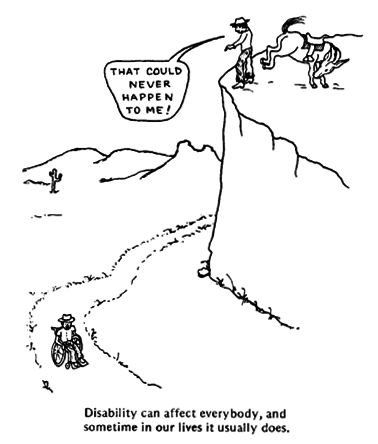 |
|
They can do this in an informal,
person-to-person way. For example, |
|
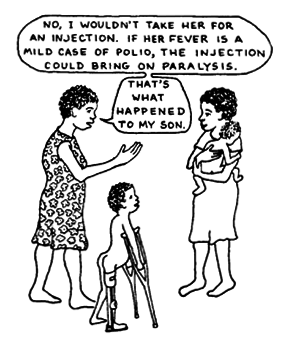 |
Or
disabled children and families can
join together to form prevention
campaigns. In one village, mothers
put on short plays to inform the
whole community about the
importance of breast feeding and
vaccination. (See
Page 74.)
In Project PROJIMO, Mexico,
disabled rehabilitation workers
have helped to vaccinate children
in remote mountain villages.In
PART 1 of this book, where we
discuss different disabilities, we
also include basic information on
prevention.
We hope that those of you who use
this book for children who are
already disabled, will also work
actively towards disability
prevention.
|
PREVENTING SECONDARY
DISABILITIES
So far we have talked mainly
about preventing original or
'primary' disabilities, such as
polio or spinal cord injury. But
the prevention of 'secondary'
disabilities is also very
important, and is one of the main
concerns of rehabilitation.
By 'secondary' disabilities we
mean further disabilities or
complications that can appear
after, and because of, the
original disability. |
|
|
017
|
For example,
consider a child with polio or
cerebral palsy who at first is
unable to walk. She gradually
loses the normal range-of-motion
of joints in her legs. Shortened
muscles, called
'contractures', keep her
legs from straightening. This
secondary disability may limit the
child's ability to function or to
walk even more than the original
paralysis:
|

This child,
after polio, gradually
developed contractures in her. |
.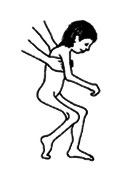
The
contractures (not the original
paralysis) kept her from being
able to stand or walk |
If the
contractures had been
prevented through early and
continued range-of-motion
exercises, the child would
have been able to stand and
walk.
Most
contractures can be corrected.
But it may take a long time
and a lot of expense - perhaps
even surgery.
It is far better to:
PREVENT CONTRACTURES BEFORE
THEY START.
|
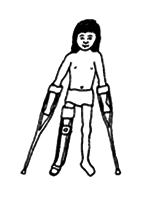 |
|
| Because
contractures develop as a common
complication in many disabilities,
we discuss them in a separate
chapter (Chapter
8). Range-of-motion exercises
to help prevent and correct
contractures are described in
Chapter 42. Use of plaster
casts to correct contractures is
described in
Chapter 59. Many
other secondary disabilities
will also develop unless
preventive measures are taken.
Some examples are pressure
sores in children with
spinal cord injury (see
Chapter 24), spinal
curve in a child with a
weak back or with one leg shorter
than the other (see
Chapter 20), head
injuries due to fits (see
Page 235). Preventive measures
for many other secondary
disabilities are discussed in the
chapters on the specific
disabilities.
In several places we discuss
problems or disabilities
that are commonly caused by
medical treatment or orthopedic
aids. For example,
 | The medicine for
fits, phenytoin,
produces serious swelling of the
gums in some children. This can
partly be prevented by brushing
the teeth regularly. (See
Page 238.) |
 | Crutches
that press hard under the armpit
can damage nerves and gradually
paralyze the hands. Shorter
crutches, or lower-arm crutches
(like those shown above) prevent
this problem. (See
Page 393.) |
 | Surgery is
sometimes done to remove
contractures that actually help
a child to move or function
better. So worse difficulties
result. The benefits or possible
harm of surgery should be
carefully evaluated
before it is done. (See
Page 530.) |
 | Some braces or aids that
help a child at first, may later
actually hold her back. (See
Page 526 to 529.) |
To prevent these mistakes, it
is essential to evaluate
the needs of each child carefully,
and repeat evaluations
periodically. We must
take great care to prevent further
disability caused by treatment.
|
The first
responsibility of a
rehabilitation worker or
parent, like the healer,
should be to: DO NO HARM |
|
|
|
018
|
| In
addition to secondary disabilities
that are physical, others may be
psychological or social (affecting the
child's mind, behavior, or place in
the community). Some disabled
children develop serious
behavior problems. This is
often because they find their bad
behavior brings them more attention
and 'rewards' than their good
behavior.
Chapter 40 discusses ways that
parents can help prevent tantrums and
bad behavior in disabled children.
The biggest secondary
handicap for many disabled children
(and adults) usually comes from the
lack of understanding and acceptance
by other people.PART
2 of this book talks about how the
community can be involved in taking a
more active, supportive role in
relating to the disabled and helping
them to meet their needs. In
PART
2 we also discuss what disabled
persons and their families can do, in
the community, to promote better
understanding and prevent disability
from becoming a serious handicap.
|
Prevention of secondary
disability is a basic part of
rehabilitation. |

THE NEED FOR
MORE SENSIBLE AND
LIMITED USE OF INJECTIONS |
|
 |
The overuse and misuse of
medicines in the world today has
become a major cause of health
problems and disabilities.
This is partly because medicines
are so often prescribed or given
wrongly (for example, certain
medicines taken in pregnancy can
cause birth defects,
see Page
119). And it is partly because
both poor families and poor
nations spend a great deal of
money on overpriced, unnecessary,
or dangerous medicines.
The money could be better spent
on things that protect their
health-such as food, vaccinations,
better water, and more appropriate
education. Some medicines, of
course, when correctly used are of
great importance to health. But
most are not. Of the
30,000 medicinal products sold in
most countries, the World Health
Organization say that only about
250 are needed.
|
In
many countries, injections
have become the 'modern magic'.
People demand them because doctors
and health workers often prescribe
them, and doctors and health
workers prescribe them too often
because people demand them. |
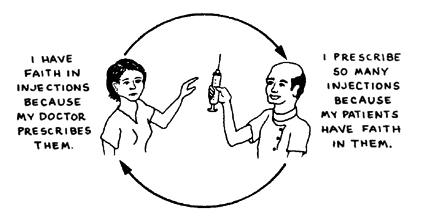 |
|
|
019
|
|
HOW INJECTIONS DISABLE
CHILDREN |
|
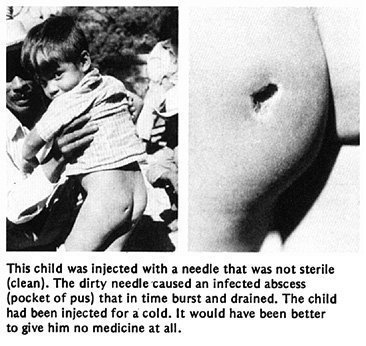 |
Giving injections with an unclean
needle or syringe is a common
cause of infection.
Sometimes these infections can
lead to paralysis,
or spinal cord injury
(see the
story on Page 192), or death.
Also, some injected medicines can
do harm. Dangerous
allergic reactions, poisoning,
and deafness are
sometimes caused by injecting
certain medicines - often when
they are not needed.
Overuse by doctors and midwives
of injectable hormones
to speed up childbirth and 'give
force' to the mother has become a
major cause of babies born with
brain damage, cerebral
palsy, and fits
in many countries.
|

The disability most often caused
by injections is paralysis
from polio. Some experts
say that each year up to 2
million children are paralyzed by
polio because of injections.
Nearly all of these injections are
given when they are not needed.
It happens like this. Children
who are infected by the polio
virus usually only have signs of a
bad cold or 'flu'. Most get well
in a few days, without developing
paralysis. But the risk of
paralysis increases if the child's
muscles are injured or irritated.
Injections of any kind of medicine
irritate the muscles. Messages
from the irritated muscles travel
up the nerves to the
spinal cord, and
cause changes that let the polio
virus produce paralysis.
Unfortunately, when children
develop a cold or 'flu' caused by
the polio virus, their parents
often take them to a doctor or
health worker for an injection.
Many times the result is
paralysis, which is usually worse
in the leg on the side that was
injected. Many people used to
think that paralysis in a leg
after an injection was caused
because the needle 'hit a nerve'.
We now know that in most cases the
paralysis was caused by polio.
Because it was brought on or
'provoked' by an injection, this
is called 'provocation polio'.
It is very important that
mothers-and doctors-remember that
children should not be
given injections when they have
signs of a cold with fever or
'flu'. It might be polio, and an
injection could bring on
paralysis.
|
If
injections are given to
children only when they are
really needed,
millions of cases of
paralysis from polio could
be prevented. |
|
|
|
020
|
| The
worldwide epidemic of
unnecessary injections
each year sickens, kills, or
disables millions of persons,
especially children. An
international campaign is needed
to re-educate doctors, health
workers, traditional healers (many
of whom also now overuse
injections), and the people
themselves. Combating
misuse and overuse of medicines is
as important a preventive measure
as is vaccination, clean water, or
the correct use of latrines.
Health workers, schoolteachers,
and community organizers should
all work to 'de-mystify' or take
the magic out of injections, and
to help people always to
weigh the possible risks and
benefits before using any
medication.
For skits and ideas on teaching
people about the danger of
unnecessary injections, see
Helping Health Workers
Learn,
Chapters 18,
19, and
27. |
Note:When
used correctly, certain
injected medicines are
important to health.
Vaccinations, including
those that are injected,
are very important to
protect a child's health
and prevent disability.
However, to avoid
paralysis from polio,
it is best not to
give vaccinations
(immunizations) or any
other injection when a
child has a fever or signs
of a cold. This could be a
mild polio infection, and
giving an injection could
cause paralysis. |
|
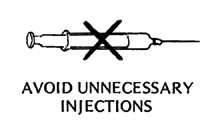 |
|
WAR AS A CAUSE OF CHILD
DISABILITY
Armed violence is
increasing. Since 1980, 45
countries have been involved
in 40 wars, with over four
million soldiers. In
today's wars, more civilians
than soldiers are killed or
disabled, and most are women
and children. In
World War One, only 5 percent
of persons killed or injured
were civilians. Today, 80 to
90 percent are civilians. At
least 3 times as many people
are injured as are killed.
The increased poverty and
'hard times' caused by war
also lead to many
disabilities. There are 25 to
30 million refugees, many
living under dangerous and
unhealthy conditions. One-
third of the world's children
lack adequate food and basic
health care. Millions are
homeless. Yet in 1985, world
leaders spent 1,000 billion US
dollars on war and arms-twice
as much as in 1981.
War, terrorism, and torture
have become tools of the
powerful for economic,
political and social control.
When the peoples of poor
countries dare to get rid of
their dictators and form
popular governments that work
toward fairer distribution,
the rich, powerful countries
often try to destroy those new
governments. They pay for
terrorism, long wars, and the
destruction of schools, health
centers, and production. The
result is still more poverty,
disease, and disability.
To help change this
situation, we disabled persons
of the world must join with
all who are disadvantaged or
treated unfairly, to struggle
for a new, more truly human,
world order. |
 |
| Terrorism
is too often fought with
terrorism. During the U.S.
attack on Libya in April,
1986, bombs hit a school
for disabled children.
Such actions do not stop
terrorism; they merely
kill and disable innocent
persons. "AN EYE
FOR AN EYE WILL MAKE THE
WHOLE WORLD BLIND."
- Mahatma Gandhi. |
|
|
|
|
|